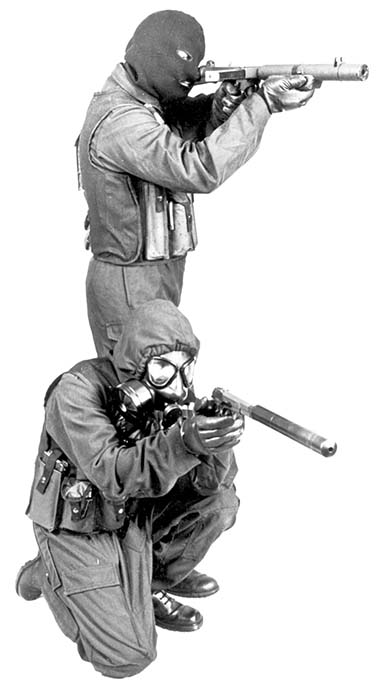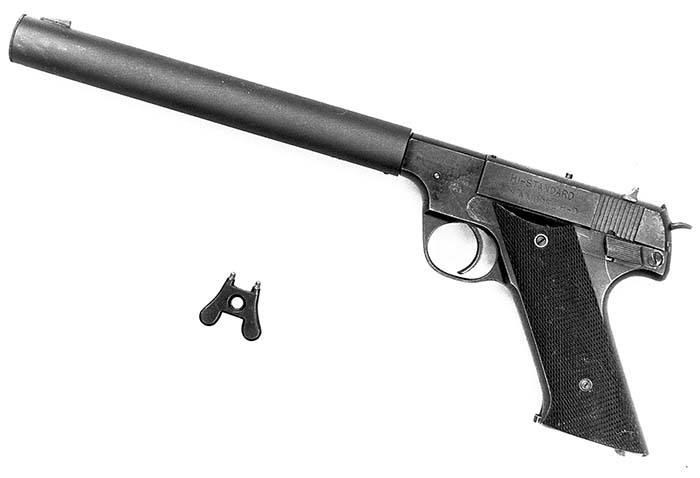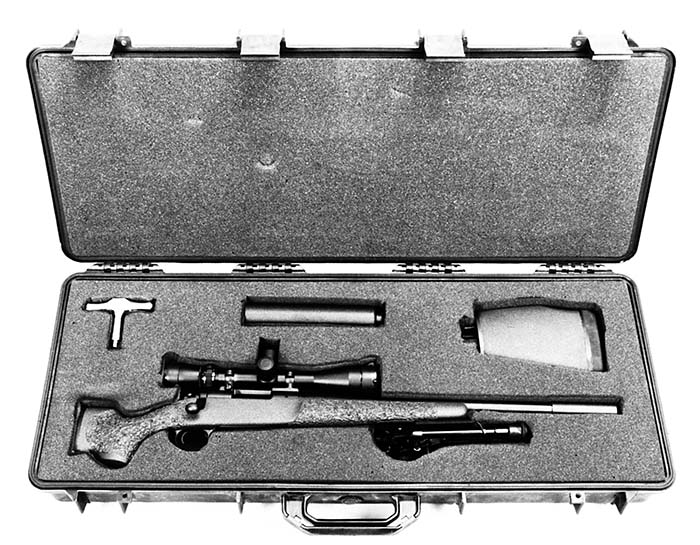By Al Paulson
Problem Solving With Low Signature Weapons: Part I

Low-signature weapons are excellent tools for solving a remarkably wide array of tactical and public-relations problems. Yet relatively few law-enforcement agencies use low-signature weapons (LSWs) to their full potential. The practical employment of LSWs extends far beyond special-response units to marksmanship training cadre and, perhaps most of all, to the small-town or county officer for whom animal-control problems represent one of the most common call-outs. The following discussion explores eleven useful missions for low-signature weapons, which achieve their low sound signatures by the use of silencers, which have been more properly called sound suppressors since the mid-1960s. Some suppressors require specialty ammunition for optimum performance while others are designed to employ standard duty loads.
Throughout the century, the development of improved silencer technology has stimulated the evolution of tactical doctrine (as well as sporting applications), and the increasingly sophisticated tactical doctrine and sporting uses have in turn stimulated the further improvement of suppressor technology. A biologist would refer to this process as co-evolution. Armed professionals have learned that sound suppressors make effective tactical tools when employed for any of several reasons. Suppressors are typically used to either: (1) hide the fact that a shot has been fired; (2) hide the location of the shooter; (3) reduce public-relations and media-relations problems; (4) enhance command and control; (5) preserve operator hearing, especially in confined spaces; (6) reduce the likelihood of detonation when operating in a potentially explosive atmosphere; (7) improve the quality and safety of live-fire training; (8) reduce muzzle blast and recoil; (9) safeguard human night vision and electronic night vision devices; (10) reduce the risk of so-called “friendly fire” accidents; (11) increase operational security, and (12) improve both practical accuracy and the speed of follow-up shots. While a suppressed weapon may provide several of these functions simultaneously, the tactical user will commonly view one of these functions as the primary task of the suppressed system for a given mission. Some of the complexities involved with each of these applications are worth exploring in detail.
Hiding the Event
The uninitiated commonly believe that a silencer always hides the fact that a shot has been fired. While this effect can be achieved with the proper combination of weapon, cartridge and environmental circumstances, attaining this level of performance can be difficult. A suppressed firearm is generally used to hide the fact that a shot has been fired for one of three reasons.
(1) In the military environment, hiding the fact that a shot has been fired is essential for quietly eliminating a sentry, point man or other hostile without alerting nearby individuals. In the law-enforcement environment, officers face an increasing incidence of hostage situations. When that involves quietly dealing with multiple armed suspects in a large building, the risk level increases dramatically. The ability to quietly remove one threat without alarming other armed suspects can save lives.
(2) Both law-enforcement and military operations also may need to quietly eliminate a guard dog. While the 9x19mm round from the H&K MP5 SD has not proved to be effective in this role, an MP5 chambered in .40 S&W and employed with a good muzzle can holds more promise. Some departments prefer an integrally suppressed Marlin Camp Carbine in .45 ACP from companies like John’s Guns or SIOPTS for this role. Finally, the new Ruger Model 96/44 lever-action rifle and the Ruger Model 77/44 bolt-action rifle, fitted with a Dark Star suppressor from Sound Technology and employing heavy .44 Special rounds, provide effective tools for dispatching animals as large as deer.
(3) An increasingly common law-enforcement requirement is to quietly destroy selected objects (such as vehicle tires or yard lights) prior to a dynamic entry or pursuant to another tactical operation. Unless there is considerable environmental noise (such as a helicopter overhead in the law-enforcement realm or a nearby firefight in the military realm), hiding the fact that a shot has been fired generally requires the use of subsonic ammunition to avoid the loud ballistic crack that would be generated by a supersonic projectile.

It is important to understand that the use of subsonic ammunition limits the effective range of a weapon. If the suppressed firearm employs subsonic ammunition with a poor ballistic co-efficient (such as the 9x19mm and .45 ACP pistol cartridges), then the system could have a maximum effective range on the order of 100 yards (91 m). If the subsonic weapon employs ammunition with a good ballistic coefficient (such as the 7.62x39mm and 7.62x51mm NATO subsonic rifle cartridges), then the system could have a maximum effective range on the order of 200 yards (183 m). The outstanding 300 Whisper cartridge developed by J.D. Jones for SSK Industries can deliver 1 MOA accuracy at 200 yards in the proper suppressed weapon. The 53 grain 5.56x45mm Ultra Stealth subsonic round from Engel Ballistic Research will deliver 1 MOA from a 1 in 9 barrel at 87 yards (80 m), while Engel’s 220 grain 7.62x51mm Thumper subsonic rounds will deliver 2 MOA at 87 yards (80 m) with a 1 in 12 barrel. Both will defeat Level III-A body armor. Bullet flight noise produced by these subsonic rifle cartridges is less than the sound produced by an arrow in flight. The dominant sound with a well-designed suppressor then becomes bullet impact.
In practice, placing accurate hits at random distances out to 200 yards with a subsonic rifle cartridge is very difficult. Two factors create most of the problems: the rifling’s rate of twist, and range estimation. While current laser range-finding binoculars solve the latter problem, finding a source for barrels of the proper twist rate can be a challenge.
A fast rate of twist is typically needed to stabilize a subsonic projectile of conventional weight, although a new 7.62x51mm subsonic round developed by Black Hills may provide acceptable accuracy out to 100 yards using rifles with a 1 in 12 twist (like the Remington PSS) and good accuracy with a 1 in 10 twist (like the Savage Model 110FP “Tactical Rifle”). But that’s not universally true. Several superb custom rifles with barrel lengths of 20, 24, and 27 inches (51, 61, and 69 cm), featuring either polygonal or cut rifling, would barely place five shots on a sheet of 8.5×11 inch (22×28 cm) paper. Some shots were very high and some were very low, suggesting irregular ignition (a common problem with small powder charges in large-volume cases). Shooting on a hot, dry day at an altitude of about 1,500 feet (457 meters), only 20 percent of the Black Hills rounds remained subsonic in the three aforementioned custom rifles.
The Sound Technology subsonic round, on the other hand, delivered better than 0.5 MOA groups in the Savage Tactical rifle with Sound Technology Dark Star suppressor and the barrel shortened to 20 inches (51 cm).
Depending primarily on bullet length, some 5.56x45mm subsonic rounds are accurate to 80-90 yards with a 1 in 9 twist, while the SIOPTS subsonic rounds featuring ultra-heavy frangible tungsten projectiles require a 1 in 7 twist and a Colt milspec (as opposed to aftermarket or match) chamber and then provide excellent accuracy to at least 100 yards. I’ve not had the time to determine the SIOPTS round’s accuracy at 150 and 200 yards at the time of this writing; this may well prove to be a 200 yard cartridge.
Many subsonic cartridges employ a heavier than normal bullet to improve both external and terminal ballistics (which translate into improved shot placement and better stopping power). Using a heavier bullet may require such a fast rate of twist that appropriate barrels are extremely difficult to obtain, even from custom barrel makers. A further complication is that such a fast-twist barrel probably won’t provide acceptable performance with conventional supersonic ammunition, so it is generally necessary to dedicate a rifle to a subsonic cartridge. This is a good idea anyway, since a subsonic 7.62x51mm subsonic round will strike 4 to 14 inches lower than Federal .308M ammunition at 100 yards, depending on the design of the subsonic ammunition. Few centerfire rifles will perform well with both supersonic and subsonic ammunition. The most notable exception is the Savage Model 110FP Tactical Rifle with Sound Technology’s Dark Star sound suppressor and Choate’s Ultimate Sniper Stock. These three components together form a suppressed rifle system that provides superb sound reduction, 1/2 MOA accuracy with Federal .308M supersonic ammo and 1/4 MOA accuracy with Sound Technology subsonic loads.
The ability to instantaneously tell subsonic from supersonic ammunition becomes crucial if both subsonic and supersonic rounds may be used in the same rifle. European manufacturers tend to put a blue tip on the bullet of subsonic rounds, and at least one uses a blue case head. Subsonic 5.56x45mm and 7.62x51mm rounds from Engel Ballistic Research feature a white tip. And subsonic rifle rounds from Black Hills feature nickel-plated cases. Some individuals use a needle file to add small serrations to the rims of subsonic cartridges to facilitate identification during night operations, although a simpler approach is to always keep the subsonic ammunition in a particular pocket, pouch, or magazine of different capacity or construction.
Range estimation is critical when using a suppressed rifle with subsonic cartridge at long range, even if the projectile has a good ballistic coefficient. The 7.62×51 NATO subsonic round, for example, produces a bullet drop of about 3 feet (0.9 meter) between 100 and 200 yards.
It is also important to note that a rifle fitted with a muzzle can should always be fired with the can installed, since the weight of the suppressor plus the amount of torque used to install the suppressor both affect the point of impact. The zero will generally shift 2 to 12 MOA depending on the length and weight of the suppressor, the mounting method of the suppressor, and the rigidity of the barrel. Group size, however, will generally improve slightly when a well-designed suppressor is installed properly (compared to the same barrel as it came from the factory). The only exceptions in my experience involved installing suppressors of conventional weight on rifles with long, thin barrels. Adding a suppressor to a Steyr AUG with 20-inch barrel, for example, seems to exaggerate barrel harmonics and degrade accuracy to an unacceptable level. Short-barreled AUGs do not suffer accuracy problems when a suppressor is fitted, however.
Finally, it should be noted that the psychological impact of seeing an officer armed with a suppressed weapon can work for or against the armed professional, depending on the circumstances. For example, armed suspects confronted by officers of a special-response team employing suppressed weapons are likely to perceive a greater threat level from the officers and therefore may be less likely to respond with lethal force. The flip side of that psychological coin is that some knee-jerk elements of society view suppressors as sinister technology despite overwhelming evidence to the contrary. Clearly, the thousands of civilians who legally own silencers in the United States represent an impeccably responsible and law-abiding segment of society. Furthermore, a law-enforcement officer employing a suppressor is likely to perform his duties in a more professional manner, since that officer is probably better trained and better motivated, and the suppressor itself provides additional operational alternatives. But the aforementioned knee-jerk phobia regarding suppressors common to media personnel and some civilians may work against the officer’s best interests. Therefore, it would be useful to consider several strategies for avoiding problems in the media and in the courts following an operation using a suppressed precision rifle.
The first strategy is to keep the suppressed rifle cased or in a drag bag while deploying to the shooting position or hide. The second involves what should be a penetrating glimpse into the obvious: the marksman must practice regularly with the suppressed rifle and document his maintenance of that proficiency. This process has both tactical and legal implications. Clearly, any deficiencies in the marksman’s skill level or in the performance of the suppressed rifle must be determined on the practice range and not on a deployment.
Then there is the potential danger of civil liability, which can be minimized by basic attention to detail during training exercises. Cut out the portion of the target containing the first cold shot of the day, initial and date it, and tape into the marksman’s log book. In aggregate, the log book with its actual targets will provide a powerful tool for demonstrating an officer’s expertise in the courtroom, should that ever be required.
Assuming that a suppressed firearm and its cartridge deliver sufficient accuracy and adequate terminal ballistics, it is also important to realize that the muzzle signature is only part of the story when evaluating a system for tactical employment. Two other events are involved with a suppressed gunshot which can influence the stealthiness of that shot: bullet flight noise and bullet impact.
For example, when using a .22 rimfire rifle with a muzzle suppressor for the selective destruction of objects, it is important to realize that the muzzle can will not eliminate the ballistic crack produced by high velocity and sometimes produced by standard velocity loads. The subjective impression is that the ballistic crack is as loud as an unsuppressed .22 rifle, so subsonic Long Rifles or CB Longs should normally be used for the selective destruction of objects to keep the event from sounding like a gunshot. With the resultant dramatic reduction of the weapon signature and bullet flight noise, bullet impact becomes the dominant sound of the gunshot.

When employing a suppressed centerfire rifle with conventional ammunition, for example, the bullet impact in flesh is a loud and distinctive “pukk!” If the target is engaged over an open area with little ambient (environmental) noise, bullet impact can be heard clearly for hundreds of meters. When using a suppressed rimfire rifle or when using a suppressed centerfire rifle with subsonic cartridge, the sound of bullet impact in flesh is considerably less, but it’s still distinctive. When using a subsonic rimfire round on a tire, the muzzle signature might be undetectable to an observer 33 yards (30 m) away around the corner of a house, while the bullet impact may or may not be heard as a hollow thump. When using a CB Long to break a light bulb outside a frame house, the only thing a close observer might notice is the sound of breaking glass, while occupants of the house might hear nothing. The metallic ring of a hit from a CB Long on a tire rim, however, might be quite noticeable to the house occupants.
Merely using a quality suppressed firearm does not provide a carte blanche for the operator. Some other variables that will also affect the stealthiness of a suppressed gunshot include such things as ammunition, ambient noise, location of potential hostiles relative to the target, composition of target, composition of material behind the target, presence or absence of reflective materials (such as pavement or brick walls), presence or absence of absorptive materials (such as grass, bushes and trees), and shot placement.
A final footnote to hiding the event relates to the employment of suppressors with supersonic projectiles at very close range. Entry teams are increasingly using suppressed carbines of rifle caliber (commonly the Colt M4 with a compact suppressor such as the Gemtech M4-96D, Raider from AWC Systems technology, or titanium cans from SIOPTS or the Spec Op’s Shop) because of the weapon’s superior terminal ballistics compared to a submachine gun and because the 5.56x41mm cartridge will defeat most body armor. Armed confrontations in this environment tend to be up close and personal, and a suppressed weapon may be fired at a target which is so close that the supersonic projectile does not travel far enough to generate a ballistic crack. In such cases, the dominant sounds become the suppressed muzzle blast and the sound of bullet impact. Given ideal environmental conditions and a very short engagement distance, plus an excellent muzzle can, suppressed weapons with supersonic ammunition can be very stealthy. This phenomenon has been largely ignored by professional operators, but it might provide an interesting option given the right tactical scenario.
It is much easier to hide the location of the shooter than to hide the fact that a shot has been fired. While particularly valuable for military operators, this phenomenon can also be useful for law-enforcement applications as well.
| This article first appeared in Small Arms Review V1N10 (July 1998) |










